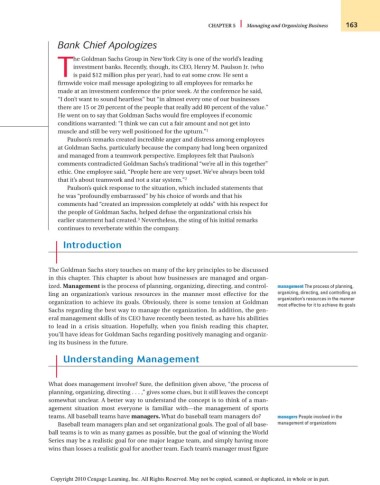Page 189 - Introduction to Business
P. 189
CHAPTER 5 Managing and Organizing Business 163
Bank Chief Apologizes
he Goldman Sachs Group in New York City is one of the world’s leading
investment banks. Recently, though, its CEO, Henry M. Paulson Jr. (who
Tis paid $12 million plus per year), had to eat some crow. He sent a
firmwide voice mail message apologizing to all employees for remarks he
made at an investment conference the prior week. At the conference he said,
“I don’t want to sound heartless” but “in almost every one of our businesses
there are 15 or 20 percent of the people that really add 80 percent of the value.”
He went on to say that Goldman Sachs would fire employees if economic
conditions warranted: “I think we can cut a fair amount and not get into
muscle and still be very well positioned for the upturn.” 1
Paulson’s remarks created incredible anger and distress among employees
at Goldman Sachs, particularly because the company had long been organized
and managed from a teamwork perspective. Employees felt that Paulson’s
comments contradicted Goldman Sachs’s traditional “we’re all in this together”
ethic. One employee said, “People here are very upset. We’ve always been told
that it’s about teamwork and not a star system.” 2
Paulson’s quick response to the situation, which included statements that
he was “profoundly embarrassed” by his choice of words and that his
comments had “created an impression completely at odds” with his respect for
the people of Goldman Sachs, helped defuse the organizational crisis his
3
earlier statement had created. Nevertheless, the sting of his initial remarks
continues to reverberate within the company.
Introduction
The Goldman Sachs story touches on many of the key principles to be discussed
in this chapter. This chapter is about how businesses are managed and organ-
ized. Management is the process of planning, organizing, directing, and control- management The process of planning,
ling an organization’s various resources in the manner most effective for the organizing, directing, and controlling an
organization’s resources in the manner
organization to achieve its goals. Obviously, there is some tension at Goldman
most effective for it to achieve its goals
Sachs regarding the best way to manage the organization. In addition, the gen-
eral management skills of its CEO have recently been tested, as have his abilities
to lead in a crisis situation. Hopefully, when you finish reading this chapter,
you’ll have ideas for Goldman Sachs regarding positively managing and organiz-
ing its business in the future.
Understanding Management
What does management involve? Sure, the definition given above, “the process of
planning, organizing, directing ...,” gives some clues, but it still leaves the concept
somewhat unclear. A better way to understand the concept is to think of a man-
agement situation most everyone is familiar with—the management of sports
teams. All baseball teams have managers. What do baseball team managers do? managers People involved in the
Baseball team managers plan and set organizational goals. The goal of all base- management of organizations
ball teams is to win as many games as possible, but the goal of winning the World
Series may be a realistic goal for one major league team, and simply having more
wins than losses a realistic goal for another team. Each team’s manager must figure
Copyright 2010 Cengage Learning, Inc. All Rights Reserved. May not be copied, scanned, or duplicated, in whole or in part.

